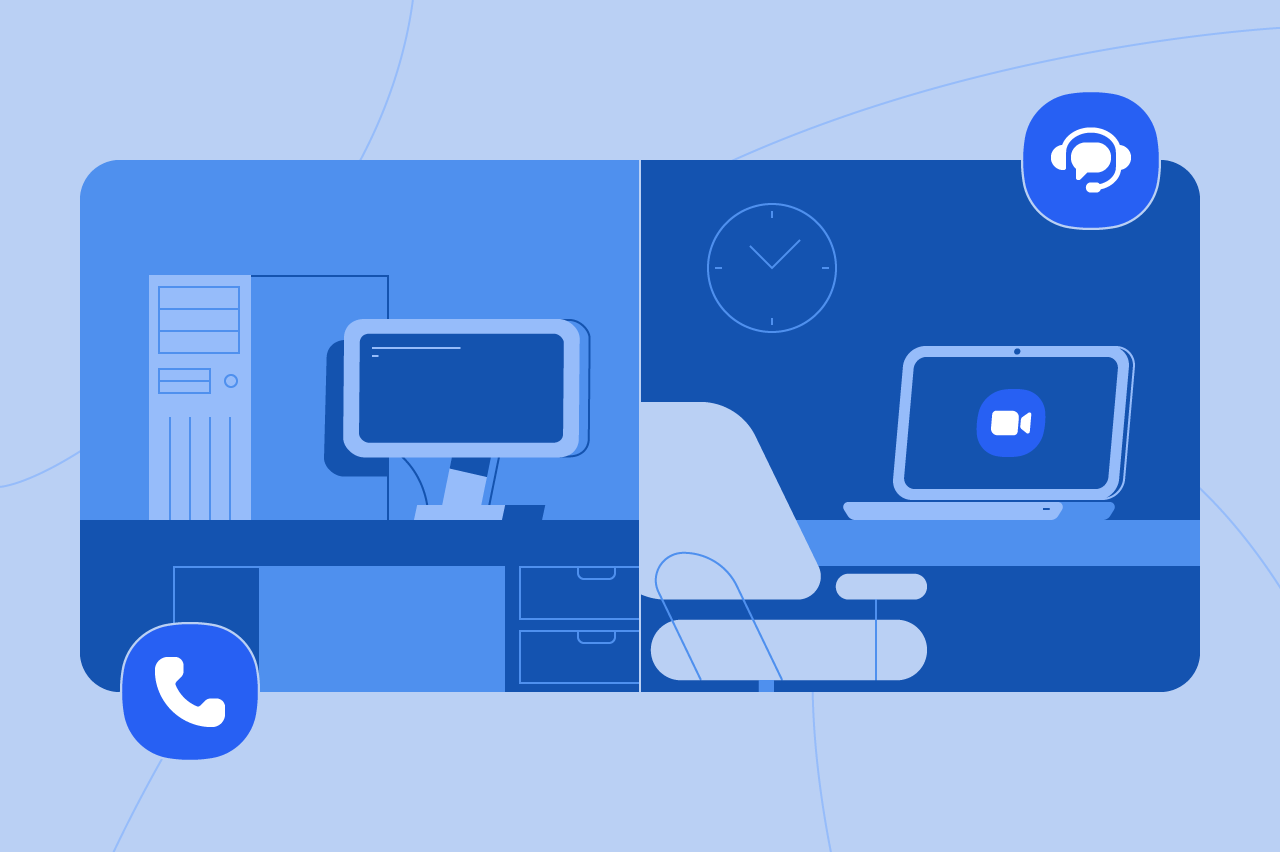
What is a cloud contact center and how to choose the best one
Explore what a cloud contact center is and how it's different from traditional contact center solutions. Explore features and tips to choose the right software.
Updated on April 12, 2023
Published on April 11, 2022


If managed correctly, a problem with a product or service isn’t the end of a customer relationship. However, quickly resolving issues can be challenging, particularly if the customer is angry, frustrated, or uncooperative. Learning how to de-escalate angry customer calls will improve customer support experiences and key performance indicators (KPIs), and make your agents’ jobs easier.
Here’s everything you need to know.
To understand de-escalation, you need to look at escalation. When the customer support agent begins the conversation, it’s good to remember that the customer may be starting the interaction with heightened emotions and less patience than normal.
If the agent doesn’t de-escalate the situation, the customer may grow even more angry, frustrated, and impatient, and request to speak to a manager. By that time, the customer’s stress may be an 11 on a 10-point scale.
De-escalation techniques interrupt the cycle of anger and emotion, help calm the customer, and allow the support agent and customer to agree on how to resolve the issue.
If you were to ask your customers what constitutes a good experience, few would cite lengthy processes to resolve issues or deal with indifferent and unhelpful customer support agents. Of course, businesses and their customers aim for flawless transactions, products that always work perfectly, and minimal conflict or misunderstandings.
But errors and missteps are a fact of life. De-escalating those situations can preserve customer relationships and create positive impressions of your brand.
The 3R Method, as taught by expert customer service and de-escalation expert, Myra Bryant Golden, is one of the most effective ways to guide a customer from frustration to issue resolution. The three “Rs” of this process are the following.
The first step in de-escalating a tense situation on a customer support call is to recognize that there is one. It’s vital to carefully listen to what the customer says during the interaction, both what they’re trying to convey literally and clues that help understand their sentiment.
Also, remember that even though the topic of a call is often framed as a complaint, the agent can’t always guess the customer’s emotional state. An agent can escalate a situation by treating a calm customer like a difficult one or minimizing customer frustration.
The agent can keep the call on track with constructive statements, such as, “I understand you,” and “I’m here to help.” Agents should also be careful not to respond in a way that further embarrasses or frustrates the person.
The next step is reframing, which gives customers greater control and helps them look at the situation differently. Agents can reframe the conversation by offering options or redirecting the customer’s focus from frustration with the problem to a potential solution.
Another way to reframe a conversation is to ask three closed-ended questions, i.e., questions they can answer with a single word, consecutively, such as yes or no questions, multiple choice questions, or rating scale questions. This helps get the agent closer to a resolution while quelling some of the customer’s anger.
The last step in de-escalating an angry customer call is to solve the problem. You may not be able to agree to the customer’s ideal solution. However, finding a fair resolution will demonstrate that you value the customer’s business, understand their issue, and want to set things right.
The benefit of following these steps is the power to turn anger into customer satisfaction and increase the chances of customer retention and loyalty.
While the 3R Method is effective, customer service agents can also use these seven methods to expertly manage calls with angry customers. Take a look.
Probably the worst thing a customer service agent can do is match the customer’s level of frustration and anger during a contentious call. It’s important to stay calm and objective, speak with a confident, empathetic tone, and stay focused on the issue.
Customers calling a service or support desk may be unable to explain their issues clearly. Listening without interrupting and then asking questions to clarify will assure them that you care about their situation and are open to helping them.
A person reaching out to a support or service desk may enter the discussion thinking it will be a contentious “me-against-them” experience. Agents who acknowledge the customer’s point of view will let them know they’re heard and put them at ease during the problem-solving process.
Another de-escalation technique is to mirror, which is to respectfully repeat what the customer says to clarify you understand what they mean. Mirroring helps agents confirm they have the correct information while validating customers with someone who understands them.
It may give customers more satisfaction if the agent identifies and explains the cause of the issue. It will reassure the customer that their problem has been resolved and that your business recognizes the pitfall and will work to avoid it.
Sometimes, it’s unavoidable, but placing a customer on hold can make their anger flare. It’s advisable to have an uninterrupted conversation, beginning to end. If you have to place them on hold, explain what you’ll be doing in the meantime, so they don’t feel you’re wasting their time.
Agents can strengthen relationships by allowing customers to voice other concerns or ask questions after deciding on a plan to resolve their issue. This gauges the customer’s emotions and creates a further plan of action.
Customer support agents can be more successful in de-escalating angry customer calls if they prepare for the possibility with these tips.
Preparation is key to how well a customer support agent handles de-escalation. Formalizing a process and empowering agents with the tools to address customer complaints will help them manage them more proficiently.
Practicing responses to various scenarios that agents may encounter will give them more confidence when facing them in the real world. Rehearsing scripts will help agents interact with customers more smoothly and confidently.
If a problem arises, evaluate the situation and review data to understand why it occurred. This information will help agents address the matter if another customer experiences something similar — and it will help you correct it so additional customers won’t call with the same issue.
As any customer support agent knows, all the preparation in the world won’t prepare them for every situation they encounter. However, we’ve compiled a list of FAQs from support teams looking for guidance in navigating some tricky customer situations. Read on for helpful tips for de-escalating certain common scenarios.
Use the 3R Method as you would with any customer, carefully working to understand their issue fully and to guide them through steps to resolving it.
Establishing company policies for addressing complaints and resolving conflicts will give agents the information they need on what they should and should not do. Customers will appreciate transparency and honesty throughout that process.
Never confront a customer with an assertion that they are wrong. That will escalate rather than de-escalate the situation. Instead, walk them through the facts from their service agreement, user manual, or other documentation to pinpoint their issues.
Customers can be so frustrated that they can’t overcome their emotions on their own. Focus on reframing the conversation by empathizing with them and telling them you will take them through a process that will help them find the answers they need.
Apologize, convey empathy, and resolve the customer’s issue as efficiently as possible.
De-escalating an angry customer is key to keeping customers satisfied. It’s not always easy to calm down a customer that is already upset, but the right techniques can prepare your team to provide the best service possible – even on the toughest calls. By remaining calm, actively listening, and providing solutions, you can de-escalate the situation successfully. These skills are essential for any customer support agent or staff member.
To see how Zoom’s AI-powered platform can help you improve the customer experience, learn more about our contact center and virtual agent technology, today.